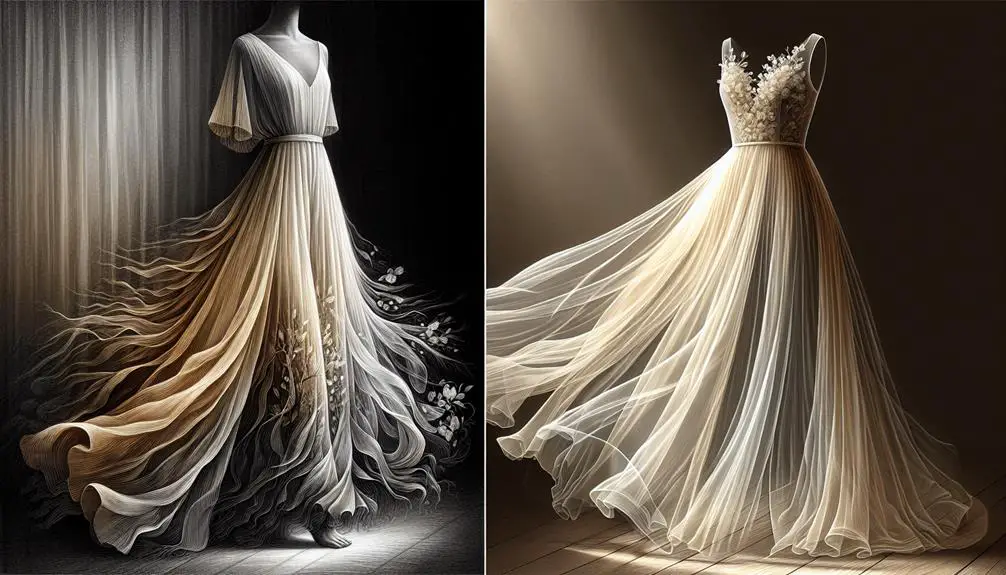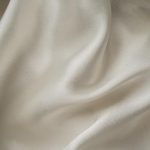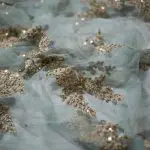Personally, I'd say whether crepe or chiffon is better really hinges on your needs. Crepe's got a crinkled texture that's forgiving on sewing errors and it drapes beautifully, making it great for both casual and upscale looks. It's also more robust and easier to maintain. Chiffon, on the other hand, is lighter, has a lovely sheer quality, and offers that perfect breezy feel for summer outfits but requires careful handling due to its delicacy. So, if you're after durability and easy care, go for crepe. For lightness and an ethereal vibe, chiffon's your best bet. Feeling intrigued? There's quite a bit more to uncover on these fabrics.
Table of Contents
Key Takeaways
- Crepe is more robust and durable, making it suitable for frequent wear and easier maintenance.
- Chiffon offers superior breathability, ideal for hot and humid climates, ensuring comfort during warm weather.
- Crepe provides better structure for formal garments like suits and pants, whereas chiffon is excellent for airy, flowy designs like gowns.
- Chiffon requires delicate care including hand washing and air drying, while crepe can often withstand machine washing.
- Crepe's opaque nature reduces the need for layering, unlike chiffon which is transparent and may require additional lining.
Understanding Crepe Fabric
Crepe fabric is known for its distinctive crinkled texture and slightly wrinkled appearance. When I'm choosing materials for my projects, I often lean towards crepe because of its unique look and feel. It's a versatile fabric that can be made from various fibers, including silk, wool, and synthetic materials like polyester. This diversity means it can be luxurious or more casual, depending on the fiber content and the weave.
What really stands out about crepe is its drape. It hangs beautifully, making it a favorite for dresses and skirts that need to flow and move with ease. Its textured surface also means it's more forgiving with minor sewing mistakes, which can be a lifesaver for a DIY enthusiast like me. Plus, it doesn't show creases as much, so it's ideal for travel wear.
Caring for crepe can be a bit tricky, though. It usually requires gentle washing and careful ironing on a low heat setting to avoid damaging the fabric. I always make sure to read the care label thoroughly to keep my crepe garments looking their best. Knowing these tips helps me get the most out of this wonderfully versatile fabric.
Exploring Chiffon Fabric
Now, let's talk about chiffon fabric.
We'll look at what makes chiffon unique and also share some tips on how to take care of it.
Understanding these points will help you see why it's so popular for both fashion and decor.
Chiffon Fabric Characteristics
Chiffon fabric often feels delightfully soft and has a slightly textured, sheer appearance. It's made from silk, polyester, or a blend, making it incredibly versatile. I've found it drapes beautifully, ideal for flowy dresses and scarves. The lightweight nature of chiffon makes it perfect for layering in fashion. However, its sheerness means you'll often see it lined or layered in designs to maintain modesty and add depth.
Chiffon's airy quality gives it a fairy-like charm, but don't be fooled; it's quite strong despite its delicate look. This strength comes from the slightly twisted yarns used in its weaving. It's this unique combination of features that really sets chiffon apart in the fabric world.
Chiffon Care Tips
Taking care of this fabric requires gentle handling to maintain its delicate texture. I've found that washing chiffon can be tricky, but it's manageable if you stick to hand washing with mild detergent. Avoid wringing it out; instead, gently squeeze the excess water. Then, lay it flat on a towel to air dry. It's a no-go for the dryer!
When it comes to ironing, set your iron to the lowest heat setting. I always place a cloth between the iron and the chiffon to protect it. Storing chiffon is straightforward; just hang it on padded hangers to prevent wrinkles.
Follow these tips, and you'll keep your chiffon looking like new!
Textural Differences
How do crepe and chiffon differ in texture? Let's dive into the tactile world of these popular fabrics. When you're choosing between crepe and chiffon, understanding their textural differences can really guide your decision, especially if you're aiming for a specific look or feel.
Here's what sets them apart:
- Texture Feel:
- Crepe: It's got a grainy, crinkly texture which gives it a slightly rough feel. This texture is due to the twisted fibers used in weaving the fabric, which create its distinctive pebbly appearance.
- Chiffon: Chiffon, on the other hand, is smooth and slightly slippery to the touch. Its lightweight nature and fine threads contribute to its sheer, soft quality.
- Fabric Weight:
- Crepe: Generally, crepe is heavier and denser, which makes it excellent for draping. It holds shape well and offers a bit of stretch.
- Chiffon: This fabric is lighter and almost ethereal. It flows and moves with ease, which is why it's often used for airy, delicate designs.
- Opacity:
- Crepe: Opaque and doesn't usually need lining.
- Chiffon: Highly transparent and often requires layering or lining to prevent see-through.
Understanding these key differences helps you pick the right fabric for your project without stepping foot into the next topic of versatility and uses.
Versatility and Uses
Now that we've explored the textural differences, let's look at how crepe and chiffon are used in various fashion and design contexts. Crepe's slightly crinkled texture and heavier weight make it perfect for creating more structured garments like suits and pants. It's also great for dresses that require a bit of drape without being too flowy. On the other hand, chiffon is the go-to for those breezy, ethereal pieces that flow beautifully. It's often used in evening wear, like gowns and cocktail dresses, as well as in blouses that need a bit of a translucent touch.
I've noticed that crepe can be a bit more versatile when it comes to seasonal wear. It's substantial enough for cooler months, yet breathable for warmer weather. Chiffon, while predominantly popular in spring and summer collections, can sometimes be layered in colder seasons for a chic, lightweight feel under heavier pieces.
In terms of design applications beyond clothing, chiffon serves well in accessories like scarves and wraps due to its light, airy quality. Crepe, with its sturdier form, is excellent for items that require more shape and longevity, such as designer bags and artistic upholstery. Both fabrics bring unique qualities to the table, making them indispensable in the fashion world.
Durability Comparison
Let's dive into how durable crepe and chiffon are when compared to each other. When choosing between these fabrics, understanding their longevity under various conditions can really guide your decision. So, here's a breakdown:
- Fabric Composition:
- Crepe is typically made from silk, wool, or synthetic fibers like polyester, making it generally more robust. The tightly woven nature of crepe gives it a good resistance against wear and tear. Chiffon, on the other hand, is lighter and usually crafted from silk or synthetic materials like nylon. Its weave is less dense, which can make it more susceptible to snagging and tearing.
- Maintenance and Care:
- Crepe is easier to maintain due to its sturdier structure. It doesn't wrinkle easily and can handle machine washing better than chiffon, which often requires delicate handling, including hand washing or dry cleaning to avoid damage.
- Longevity in Use:
- Due to its resilience, crepe tends to hold up better over time. It's less prone to fraying compared to chiffon. Whether for daily wear or special occasions, crepe offers more durability, retaining its shape and texture longer than the more delicate chiffon.
Understanding these aspects can help you choose wisely based on how long you expect your outfit to last!
Comfort and Wearability
When I think about what makes a fabric comfy, I consider a few key things.
First off, how well does the material let my skin breathe?
Then, I look at whether it's easy to move around in and if it's practical for everyday use.
Breathability and Skin Comfort
Regarding breathability and skin comfort, crepe and chiffon fabrics offer distinctly different experiences. If you're like me, always juggling between comfort and style, understanding these nuances is key. Here's what you need to know:
- Crepe: It's denser and offers less breathability compared to chiffon. However, it's remarkably soft on the skin, which makes up for the less airy feel.
- Chiffon: This fabric is the champion of breathability. Its light and airy nature makes it a go-to for those hot, sticky days. But remember, it's slightly less soft to the touch compared to crepe.
- Personal Preference: Ultimately, choosing between crepe and chiffon boils down to what feels best on your skin and what meets your breathability needs.
Daily Wear Suitability
I often find myself weighing the pros and cons of crepe and chiffon for daily wear, focusing on their comfort and overall wearability.
Crepe, with its slightly crinkled texture, offers a durable choice that doesn't wrinkle easily, making it ideal for a busy day. It's also generally more opaque, which means I don't have to fuss over layering.
On the other hand, chiffon is lighter and gives a lovely, airy feel, but it's also quite transparent and can snag easily, which isn't great when I'm on the go.
Both materials have their benefits, but for practicality and ease, crepe often edges out. It keeps me looking sharp without the constant worry of maintenance.
Flexibility and Movement Ease
Turning to the flexibility and ease of movement, crepe stands out as it stretches more comfortably around the body, unlike chiffon which, while flowy, can restrict movement because of its delicate nature. When I'm choosing outfits for events where I'll be active, such as dancing or mingling through crowds, crepe is my go-to. It hugs and moves with me, making it feel almost like a second skin.
Here's why I prefer crepe for comfort and wearability:
- Stretchability: Crepe fabric offers better stretch, adapting to body movements effortlessly.
- Structure: It maintains a shape that isn't too clingy, avoiding the stiffness often felt with chiffon.
- Durability: Crepe withstands more wear and tear, making it ideal for frequent use without losing its charm.
Suitability for Different Climates
When choosing between crepe and chiffon, it's crucial to consider the climate you live in. Crepe, with its thicker texture, is fantastic for cooler climates. It holds in warmth slightly better than lighter fabrics, making it a cozy choice for fall and winter. I've worn crepe dresses to winter weddings and felt both stylish and warm.
On the other hand, chiffon is a lifesaver in hot and humid conditions. Its light, airy nature allows your skin to breathe, making sweltering summer days more bearable.
I remember wearing a chiffon blouse on a trip to a tropical country, and it was perfect for the humid weather; I felt cool and comfortable throughout the day. In contrast, when I tried a crepe top under similar conditions, it didn't take long for me to feel a bit overheated.
Care and Maintenance
Caring for crepe and chiffon fabrics requires a bit of know-how to keep them looking their best. Let me tell you, it's not as daunting as it sounds! Both materials are delicate, but with the right approach, you can maintain their beauty and extend their lifespan significantly.
Here's what you need to know:
- Washing: Always check the care label first. Generally, crepe can often be hand washed with gentle detergent in cold water, whereas chiffon, especially silk chiffon, is better off dry cleaned. If you're ever in doubt, opt for dry cleaning to avoid any mishaps.
- Drying: Never wring out crepe or chiffon to dry. For crepe, lay the garment flat on a towel and roll it up to absorb excess water. Chiffon should be hung on a padded hanger to air dry. Avoid direct sunlight as it can fade the colors.
- Ironing: Use a low heat setting and always place a pressing cloth between the iron and the fabric. For crepe, a slight steam can help eliminate wrinkles, while chiffon requires a dry iron to prevent water spots.
Stick to these tips, and you'll keep your crepe and chiffon outfits in top-notch condition!
Fashion Trends and Preferences
Both crepe and chiffon have seen shifts in fashion preferences, adapting to current trends that emphasize comfort and style. I've noticed that designers are increasingly leaning towards crepe when they want a fabric that offers a bit more structure and formality without sacrificing comfort. It's perfect for those structured dresses and tailored pants that are big in professional wear right now.
On the flip side, chiffon remains the go-to for that airy, ethereal look that's fantastic in flowy dresses and blouses. It's especially popular in the spring and summer collections, where lighter materials dominate. What's interesting is how both materials are being mixed with others to create textures and layers that are both visually appealing and comfortable to wear.
I'm seeing more people choose crepe and chiffon based not just on the occasion, but also on the time of year and the specific style they're aiming for. It's all about versatility and adapting these fabrics to fit personal style and comfort, rather than sticking to traditional uses. This approach really opens up a lot of possibilities for personal expression through fashion, which I think is fantastic for anyone wanting to master their own unique look.
Frequently Asked Questions
Can Crepe or Chiffon Fabrics Cause Skin Allergies?
I've researched whether these fabrics can cause skin allergies. Both crepe and chiffon might trigger reactions if you're sensitive to specific fibers. It's crucial to check the material composition before wearing.
Are Crepe and Chiffon Fabrics Vegan-Friendly?
I've looked into whether crepe and chiffon are vegan-friendly. Both fabrics can be made from synthetic or plant-based fibers, so they're generally vegan. However, silk chiffon isn't vegan since it's derived from silkworms.
How Do Crepe and Chiffon React to Dyeing?
When I dyed my chiffon scarf, it took the color lightly, creating a soft hue, while the crepe dress absorbed it deeply, resulting in a vibrant shade. Both fabrics react uniquely to dyeing.
What Is the Environmental Impact of Producing Crepe Versus Chiffon?
I'm exploring the environmental impact of fabric production. Crepe generally uses more energy and chemicals than chiffon, which often involves silk and can be more biodegradable but has issues with sericulture.
Are There Hypoallergenic Treatments Available for Crepe or Chiffon?
I've found that both crepe and chiffon can be treated to be hypoallergenic. It's a great option for those with sensitive skin, ensuring comfort without sacrificing style.
- Is Pure Chiffon Costly? - April 23, 2024
- What Is Similar to Chiffon? - April 23, 2024
- Which Material Is Better Crepe or Chiffon? - April 23, 2024






